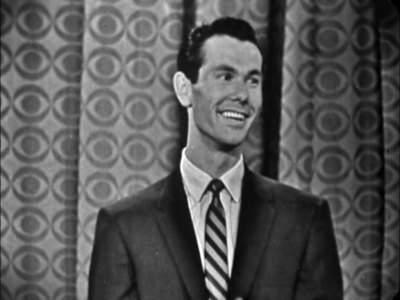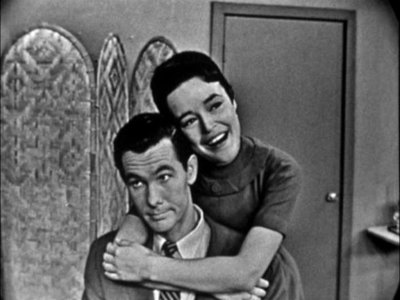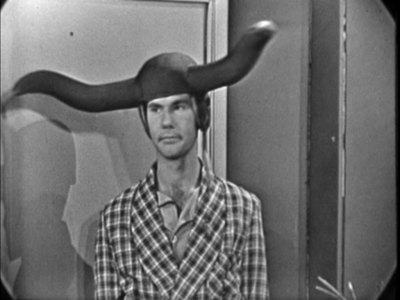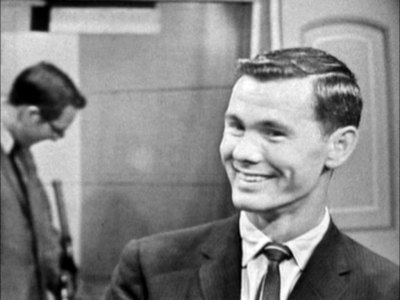| Reviews & Columns |
|
Reviews DVD TV on DVD Blu-ray 4K UHD International DVDs In Theaters Reviews by Studio Video Games Features Collector Series DVDs Easter Egg Database Interviews DVD Talk Radio Feature Articles Columns Anime Talk DVD Savant Horror DVDs The M.O.D. Squad Art House HD Talk Silent DVD
|
DVD Talk Forum |
|
|
| Resources |
|
DVD Price Search Customer Service #'s RCE Info Links |
|
Columns
|
|
|
Johnny Carson Show, The
The Johnny Carson Show, Shout Factory's two-disc compilation of kinescopes from the King of Late Night's first and only sustained foray into prime time network TV, is an amazing find for TV historians and fans of Carson. Long thought lost, these recently discovered kinescopes of Johnny's 1955 CBS prime time variety show present an impossibly young Johnny Carson already possessing many of the comedic skills he would utilize on his thirty year run as the one and only true host of NBC's The Tonight Show. Included on this set are also long-lost clips from Carson's CBS daytime talk show and his ABC game show, Who Do You Trust? The Johnny Carson Show is a tremendously important addition to television history, showcasing one of TV's true icons at his earliest incarnation - and, more importantly, it's funny.

Television afficionados and Carson fans are familiar with the story. Working in radio and TV in Omaha, Nebraska after the war, Carson came to Los Angeles in 1951, appearing in a popular, locally televised TV show, Carson's Cellar. Movie and TV comedy legend Red Skelton was a fan of the show, and invited the clean-cut, Midwestern kid from Nebraska to come aboard his writing stable for Skelton's comedy variety show that had recently moved to CBS in September of 1953. One evening, Skelton, known for his knockabout slapstick antics, injured himself during rehearsal just hours before his live broadcast, and it was suggested that young Carson take over the hosting duties for the night. Carson evidently did very well, because the network brass made plans for Carson to come out from behind his typewriter to go before the CBS cameras. His first stint was the brief, summer replacement game show series, Earn Your Vacation, that ran from May to September of 1954. It was by all accounts, not a happy experience for Carson, but it did get him out in front of a national audience, and helped steel him for his next big assignment: the host of CBS's highly touted new comedy variety show, The Johnny Carson Show.
Premiering on the last day of June in 1955, The Johnny Carson Show was given the big push by CBS and William Morris (Carson's talent agency at the time). Quite a bit of publicity was generated by the network to pre-sell the series, and quite a lot of care was lavished on the show, with CBS intent on building up Carson into the "next" George Gobel (Gobel had catapulted into national prominence with his low-key comedy skills on NBC). However, the care that CBS put into The Johnny Carson Show was apparently smothering right from the start. After a shaky start in the ratings, CBS didn't give the show time to coherently jell in the audience's minds, bringing in eight different writers and seven different directors (almost unheard of in those days) during the series' brief, 39 week run. In the face of disastrous ratings, The Johnny Carson Show was canceled on March 29th, 1956.
Now fans of The Tonight Show will remember that Carson used to take particular delight in mentioning his previous unsuccessful forays into television and movies (his first, disastrous movie appearance in 1964's Looking for Love would become a running joke for three decades), and at times on The Tonight Show, he would mention his first network stint on The Johnny Carson Show. But many historians and fans assumed that the kinescopes were lost for the The Johnny Carson Show (most network TV shows at the time were still broadcast live, so for recording purposes, they were photographed off a television monitor with 16mm film, known as a kinescope). Indeed, most of the videotapes for The Tonight Show prior to 1972 were criminally wiped by NBC. But according to the eight page booklet included in The Johnny Carson Show disc set, the original 16mm kinescopes of the series were given by Johnny to his second wife, Joanne Carson. Evidently a serious film collector, Joanne received the kinescopes as a gift by Johnny because he knew she would care for them properly (according to Joanne, he enjoyed watching them with her, too -- in private, he obviously didn't think they were as bad as he stated publically). There have been previously released kinescopes from this 1955 series, but whether those were bootlegs, authorized copies by Joanne Carson, or public domain copies from collectors, I'm not sure. The timing varies on each particular episode, with some running as briefly as nineteen minutes, and others almost twenty-four. Now, the live nature of the show's production may account for some variation in the running time, but obviously, for whatever reasons, post-production editing of these kinescopes has occurred, with the emphasis always put on showcasing Carson. However, the breadth and quality of these particular kinescopes would certainly suggest they're the definitive look at this particular period in Carson's TV career.

For The Johnny Carson Show two disc collection, ten episodes of the comedy variety series are included, spanning the entire run of the series, and starting with the premiere episode. Having never seen Carson this early in his career, I was struck at how self-assured he was (despite his youth and relative inexperience before the cameras). Loping out from behind the CBS logo-festooned curtains, Carson looks like a gangly teenager here (he was actually 30 years old), and his stagecraft does belie some nervousness and apprehension. But stronger is the apparent confidence and ease that Carson summons when a particular joke hits home, and the obvious pleasure he derives from successfully cracking up the audience. The Johnny Carson Show was derided by Carson himself as having little or no internal direction, with too many voices putting in their two-cents worth on what the show should look and sound like. And that's apparent as you watch the chronological progression of the sketches over the two discs. They tried to put Carson in every kind of skit imaginable, instead of letting him do what he does best: a wry, slightly sardonic, laid back delivery filtered through a good-guy, Midwestern background that let the audience root for him.
The earliest episodes are the best in this particular collection; perhaps the network initially listened to Carson and tried to do it his way before the constant fidgeting with the format began. On the premiere episode, there's a skit where TV-obsessed Johnny comes home to find his set is in the repair shop. At the beginning of the skit, the actors playing his family are frozen still, while Johnny essentially tells the entire joke to the audience before they see it. And right before he starts the skit, he backs up, and reminds them that the point of the gag is that he doesn't realize the TV set is missing. He pauses for a perfectly timed moment, and with just the faintest twinkle in his eye, deadpans, "Think about that." It's as modern and funny a moment as any you've seen countless times since the supposedly "new" comedic sensibilities of the post-Firesign Theatre and Saturday Night Live era. And that's the Johnny Carson they should have nurtured in the various sketches of The Johnny Carson Show: the totally aware, self-commenting comedian who's cognizant of the gag and its intended silliness already, and who's willing to let you in on it - if you're hip enough.
Unfortunately, as the series ground on, you can see that the network tried everything but the kitchen sink to get Carson's ratings up, including lots of guest stars and big comedy production numbers that buried the amused, laid-back Carson under stale comedic shtick. Perhaps most disconcerting about The Johnny Carson Show is the then-novel use of a laugh track for a live variety show. Apparently, William Morris wanted to protect their valuable commodity, and they insisted on having a laugh track back up Carson's bits. Watching the episodes, you can readily hear where they sweetened the audiences' reactions, and at times, the track even drowns out some dialogue. This procedure must have rankled Carson, but by all accounts, Carson had little power at this point in his career to affect changes in the show. By episode #34 (the last one included on this collection), it's startlingly to see how cowed Carson had become. Visibly tired and drawn, there's an edginess to his eyes that seems to indicate he already knew the fate of the show. The energy is largely missing, even though Carson's professionalism remains.

DISC ONE:
June 30, 1955 (Episode #55-1)
In the series premiere, Johnny imitates Edward R. Murrow in a spoof of Murrow's Person to Person program featuring Johnny's first wife Jody and their three children. In Catch Up With the News, Johnny plays a roving reporter.
July 21, 1955 (Episode #55-4)
Johnny imitates Walter Cronkite, takes a look at the pitfalls of marriage, and parodies Goldilocks And The Three Bears and You Are There.
August 25, 1955 (Episode #55-9)
Sketches include a spoof of the Russian ballet, Catch Up With The News and a 1950s-style look at the future, as Johnny imagines what life will be like in 1980.
September 1, 1955 (Episode #55-10)
Johnny plays Dillinger, The Mental Wizard, in a parody of Joseph Dunniger, the famous mind reader (This sketch is the early inspiration for Carson's most famous character from his Tonight Show years, Carnac The Magnificent). Another sketch finds Johnny playing tourist in Paris; we also get an idea of what might happen to your television reception near an airport.
September 8, 1955 (Episode #55-1)
James Arness visits the show to promote his new series, Gunsmoke, Jack Albertson appears in a grocery store sketch and Johnny plays Colonel John J. Carson in a military sketch.
DISC TWO:
October 13, 1955 (Episode #55-16)
Johnny takes care of unfinished business; Jack Albertson appears in sketches about Johnny's fan club and bachelor life. Then Johnny plays violinist Yasha Carson.
November 3, 1955 (Episode #55-19)
Legendary movie composer Dimitri Tiomkin appears in the Johnny's Record Collection sketch. Then Johnny salutes old time Vaudeville, and stars in an epic Greek-Trojan war sketch.
December 15, 1955 (Episode #55-25)
Johnny plays a stay-at-home husband whose wife has a very unusual job. Other sketches include the Giveaway Pet Parade, a precursor to the numerous segments Johnny would do with animals later in his career, and a look at what the detective show Dragnet might have been like during the time of Alexander the Great.
January 19, 1956 (Episode #55-30)
Johnny's Navy buddy disrupts the monologue from the audience, a young Jamie Farr appears with the musical group The Double Daters, and Johnny and Eva Gabor star in The One Musketeer.
February 16, 1956 (Episode #55-34)
Dr. Samuel Hoffman, podiatrist, was catapulted to fame when he played the Theremin on the soundtrack to Alfred Hitchcock's Spellbound. He demonstrates the unusual instrument for Johnny and singer Dorothy Shay, known as "the Park Avenue Hillbilly" co-stars with Johnny in a sketch telling her life story.

The DVD:
The Video:
The full screen kinescopes for The Johnny Carson Show are quite good. The box claims they were digitally remastered, but they haven't been digitally cleaned or enhanced like the recent Elvis Presley / Ed Sullivan kinescopes. Still, they're sharp and clear.
The Audio:
The 2.0 mono soundtrack for The Johnny Carson Show accurately reflects the original television presentation. There is no close captioning option.
The Extras:
There are several worthwhile extras on The Johnny Carson Show two disc set. On disc one there's a full episode from the same named The Johnny Carson Show from May 30th, 1956. This morning chat show featuring Johnny as host was dreamed up by CBS to utilize the rest of Carson's contract with them, after the prime time The Johnny Carson Show was canceled in March of 1956. It doesn't work, probably because Johnny has to interact with other regular cast mates who add nothing to the show. Still, one can see Carson continuing to hone his skills as an interviewer. As well, there are several live Jell-O commercials from 1955 to 1956 included; Jell-O was one of the main sponsors of Johnny's prime time show. On disc two, there's a rare kinescope episode of Johnny's first true TV success, Who Do You Trust?, his ABC daytime game show modeled after Groucho Marx's You Bet Your Life. Taken from September 9, 1958, Carson's aplomb and skill are noticeably improved from his earlier The Johnny Carson Show years. As well, there's a very brief clip from the October 17, 1958 episode of The Jack Paar Show, where Johnny substituted for the absent host. It's not one of Johnny's better performances.
Final Thoughts:
As an important piece of television history, The Johnny Carson Show is an invaluable look at a critical, pivotal moment in future television icon Johnny Carson's career. As a comedy variety series, The Johnny Carson Show can still be enjoyed today, over fifty years later, largely based on the subtle, wry delivery of young Johnny Carson. Shout Factory and Joanne Carson should be applauded for putting together an attractive package of such an essential piece of entertainment history. I highly recommend The Johnny Carson Show.
Paul Mavis is an internationally published film and television historian, a member of the Online Film Critics Society, and the author of The Espionage Filmography.


|
| Popular Reviews |
| Sponsored Links |
|
|
| Sponsored Links |
|
|
| Release List | Reviews | Shop | Newsletter | Forum | DVD Giveaways | Blu-Ray | Advertise |
|
Copyright 2024 DVDTalk.com All Rights Reserved. Legal Info, Privacy Policy, Terms of Use,
Manage Preferences,
Your Privacy Choices | |||||||














